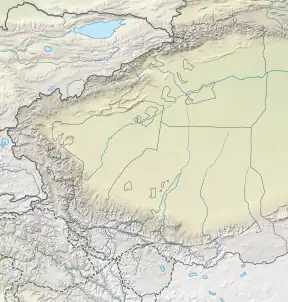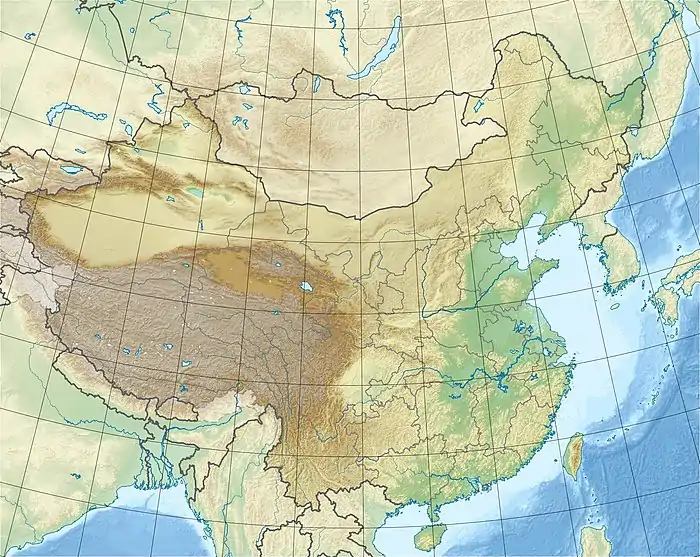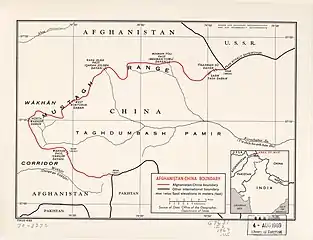Karachukar Valley
Karachukar Valley[1][lower-alpha 1] or Chalachigu Valley (Chinese: 卡拉其古河谷) is a valley in Taxkorgan Tajik Autonomous County, Xinjiang, China. It contains the basin of the Karachukar River, a tributary of the Tashkurgan River,[4] and is regarded as part of Taghdumbash Pamir.[5] The valley borders Afghanistan (Wakhan Corridor or Little Pamir) to the west and northwest, Tajikistan to the north, and Pakistan (Gojal or upper Hunza) to the south.[6] The name of the valley is from Kyrgyz, meaning "black cave".[7]
| Karachukar Valley | |
|---|---|
| Chalachigu Valley | |
 Karachukar Valley Location of Karachukar Valley in Xinjiang  Karachukar Valley Location of Karachukar Valley in China | |
| Floor elevation | 4,100 m (13,500 ft) |
| Geography | |
| Location | Taxkorgan Tajik Autonomous County, Kashgar Prefecture, Xinjiang, China |
| Coordinates | 37°9′N 74°42′E |
| Rivers | Karachukar River |
The valley is part of the Taxkorgan Nature Reserve.[8] The protected Marco Polo sheep is only found around this area.[6] The region is often referred to by the Chinese as the Chinese portion of the Wakhan Corridor.[9] There is an ethnic Kyrgyz village called Bayik (Chinese: 排依克村 or Chinese: 阿特加依里村).[10][11]
The entire Chalachigu Valley is closed to visitors. However, local residents and herders from the area are permitted access.
In March 2017, CCTV-7's Documentary for Military program[12] produced a mini-series covering the numerous border outposts in Chalachigu Valley.[13]
Mountain Passes

| Chalachigu Valley | |||||||
|---|---|---|---|---|---|---|---|
| Traditional Chinese | 卡拉其古河谷 | ||||||
| Simplified Chinese | 卡拉其古河谷[7] | ||||||
| Hanyu Pinyin | Kǎlāqígǔ xiágǔ | ||||||
| |||||||
| Karachukur Valley | |||||||
| Traditional Chinese | 喀拉其庫爾河谷 | ||||||
| Simplified Chinese | 喀拉其库尔河谷 | ||||||
| Hanyu Pinyin | Kālāqíkùěr hégǔ | ||||||
| |||||||
The valley was a significant thoroughfare of the Silk Road during ancient times. Around the valley are numerous passes connecting to other countries:
- Tajikistan - Beyik Pass
- Afghanistan - Wakhjir Pass, Tegermansu Pass
- Pakistan - Kilik Pass, Mintaka Pass
Of the above passes, it is believed that the famous Chinese Buddhist pilgrim Xuanzang traveled through Wakhjir Pass on his return trip back to China around 649 AD.[14] Some Chinese historians argue that he also used Beyik Pass on his way to India.[15]
References
- 周连宽 (1984), Dà táng xīyù jì shǐ dì yánjiū cóng gǎo 大唐西域记史地研究丛稿 [Datang Western Regions History and Geography Research Series], 新华书店北京发行所发行, p. 192
- Woodman, Dorothy (1969), Himalayan Frontiers: A Political Review of British, Chinese, Indian, and Russian Rivalries, Praeger, pp. 366–367 – via archive.org
- J. N. Price Wood (1910). "Travel & Sport in Turkestan". D. Appleton and Company.
Descending the Killik Pass we emerged into the Karachukur Valley, here about two miles wide ... forms a wedge of Chinese territory driven in between Russia and India, and joins at its western end a similar narrow tongue of Afghanistan.
- Green, Michael J. B. (1993). Nature reserves of the Himalaya and the mountains of Central Asia. Oxford University Press. p. 121. ISBN 0195629221. Retrieved 2017-02-05.
The western part is drained by the Chalachigu River, a branch of the Taxkorgan River which meets the Yarkant River north of the reserve.
- Kreutzmann 2003, p. 217, Figure 1.
- USFWS (1990-10-05). "Endangered and Threatened Wildlife and Plants; Proposed Threatened Status for Argali" (PDF). Federal Register. USDOI. Archived from the original (PDF) on 2017-02-25. Retrieved 2017-02-05.
consisting of fewer than 150 animals, was confined to the western part of the Chalachigu Valley, a finger of land extending between Afghanistan on the north and Pakistan to the south.
- 姬文志; 王宝福; 王飞 (2015-07-30). "坚守在帕米尔高原上的边防军人" (in Chinese). photo.81.cn. Retrieved 23 December 2019.
卡拉其古柯尔克孜语是"黑洞"的意思,是古丝绸之路的重要关卡,也是瓦罕走廊中国通向境外的第一站,环境恶劣,位置重要。
- "Taxkorgan Nature Reserve". icimod.org. International Centre for Integrated Mountain Development. Retrieved 2017-02-05.
Basically flat and in places more than 5km wide, the Taxkorgan Valley (the Taghdumbash Pamir on old maps) was part of the ancient Silk Route known viable population of Marco Polo sheep in China was confined to the western part of Chalachigu Valley
- "新疆边境行:记者抵达瓦罕走廊中方最西端(图)" [Xinjiang Border Tour: Reporter arrived at the Chinese westernmost point of Wakhan Corridor]. Sina News (in Chinese). Global Times. 2011-07-07. Retrieved 2017-02-05.
- 杨雪梅 (2016-09-09). "穿越瓦罕走廊(且行且思)" [Through the Wakhan Corridor]. people.gov.cn (in Chinese). People's Daily. Archived from the original on 2017-02-05. Retrieved 2017-02-05.
这里是瓦罕走廊第一村——排依克村
- 赵戈 (2016-06-13). "瓦罕走廊转场日记". xj.xinhuanet.com (in Chinese). Xinhua News Agency. Archived from the original on 2017-02-05. Retrieved 2017-02-05.
瓦罕走廊中国境内唯一的村庄--阿特加依里村
- "军事纪实" [Documentary for Military]. CCTV-7. Retrieved 23 December 2019.
- The frontier in the eyes of a company commander, retrieved 2021-08-25
- Stein, M. Aurel (1903-06-30). "Exploration in Chinese Turkestan". United States Congressional Serial Set. No. 748. Washington, D.C.: Smithsonian Institution. p. 752. Retrieved 2017-02-03.
- 于淑娟 (2014-12-24). "访谈︱侯杨方:追寻玄奘,在帕米尔复原丝绸之路". The Paper (thepaper.cn) (in Chinese). Retrieved 2017-02-02.
玄奘从这里东南行经过排依克山口到达羯盘陀国...他经过的这个山口就是符合以上这些条件的唯一路径
- Sources
- Kreutzmann, Hermann (September 2003), "Ethnic minorities and marginality in the Pamirian Knot: survival of Wakhi and Kirghiz in a harsh environment and global contexts" (PDF), The Geographical Journal, 169 (3): 215–235, doi:10.1111/1475-4959.00086
External links
- Kalachukur river basin, OpenStreetMap, retrieved 27 May 2022.